Le Déjeuner sur l’herbe – Looking at Manet’s “Luncheon on the Grass”
It is one of Édouard Manet’s famous paintings and one that has stirred up quite some controversy among the conservative 19th-century art circles, who ultimately rejected it. In this article, we take a closer look at the famous painting Le Déjeuner sur l’herbe and what exactly it is all about, and why it caused a scene.
Artist Abstract: Who Was Édouard Manet?
Édouard Manet was born on January 23, 1832. A Parisian from birth, he was interested in art from a young age and started art classes at the Collège Rollin during 1841 and during 1850 Manet furthered his art studies through Thomas Couture’s tutelage. In 1856 Manet established an art studio of his own in Paris.
Manet was exposed to numerous artists and scholars during his art career and traveled throughout Europe, including Italy.
He reportedly also studied the “Old Masters” in the Louvre. He became known as one of the most prominent artists of Modernism and his famous artwork Le Déjeuner sur l’herbe (1863) caused an uproar because of his different new style. Manet was remembered as being part of the Realism art followed by Impressionism. He died in April 1883.

Le Déjeuner sur l’herbe (1863) by Édouard Manet in Context
Édouard Manet was one of the forerunners to move away from the academic rules of painting and showed the world a glimpse of what a new, modern, painting style looked like. What was initially titled The Bath (Le Bain) and is now known as Le Déjeuner sur l’herbe, meaning “The Luncheon on the Grass”, Manet’s famous scene of a nude female picnicking with two males has become an icon of painting beyond the established rules of painting.

In the article below, we will provide an analysis of the Le Déjeuner sur l’herbe meaning by first discussing a brief background of when it was painted and exhibited, and what motivated Manet. We will then discuss a formal analysis looking more at the subject matter and stylistic approaches Manet took, which ultimately made this one of the most famous artworks to date.
| Artist | Édouard Manet |
| Date Painted | 1863 |
| Medium | Oil on canvas |
| Genre | Genre painting |
| Period / Movement | Realism |
| Dimensions | 208 x 264.5 centimeters |
| Series / Versions | Not applicable |
| Where Is It Housed? | Musée d’Orsay, Paris |
| What It Is Worth | The estimated worth is over $60 million |
Contextual Analysis: A Brief Socio-Historical Overview
When Édouard Manet painted Luncheon on the Grass it was during the 1800s in France. This was a time when the French Academy, known as the Académie des Beaux-Arts, reigned over the standards of painting, which was also referred to as Academic Painting. It followed the form and structures tied to Classical Antiquity and the Renaissance.
When Manet sought to exhibit Luncheon on the Grass at the Salon, which was the leading exhibitory group for art in Paris, in 1863 it was rejected. Subsequently, it was exhibited at the Salon des Refusés, which means “Exhibition of Rejects”.
This was an exhibition for all the paintings that were rejected for display by the Salon in Paris.

During this time Emperor Napoleon III ruled France and he tentatively allowed a new exhibition off-shoot to open after numerous complaints about rejected artworks by the Salon. This is when the Salon des Refusés came into effect. Although many critiqued the paintings exhibited here, it nonetheless introduced the avant-garde in art.
Rejecting the Status Quo
As much as the Parisian art institutions rejected Manet’s Luncheon on the Grass – including other artists like James McNeill Whistler’s Symphony in White, No.1: The White Girl (c. 1861/1862), Camille Pissarro, Gustave Courbet, and others – he similarly rejected the status quo of what was acceptable to paint and the rules to adhere by. This is what made Manet’s painting appear so risqué.

However, for a better understanding of why Manet’s painting was rejected and why it was so avant-garde for its time, we need to know a bit more about what the Academic standards for paintings were.
There were different hierarchies that deemed paintings acceptable, importantly History paintings, which explored moral and heroic messages with the religious or mythological subject matter, were the “highest” forms of paintings. This was because it required artistic skill to depict complex narratives involving numerous figures. Furthermore, these paintings were usually also on large canvases.
The next hierarchy of paintings involved Portrait paintings, Genre paintings, and then Landscape and Still Life paintings. Each genre was deemed less significant and involved smaller scales in size compared to History paintings. The subject matter was also relegated to lesser importance because it did not share a moral message like History paintings.

Although the above is a brief explanation of the different hierarchies of genres, what is important to understand is that people are expected to see certain rules followed according to the hierarchies. There was an entrenched system that, would it be averted in any way, there would be an outcry, and within this context, we can understand why the Salon rejected Luncheon on the Grass.
Due to the large scale of the painting, depicting several figures, as well as a “naked” and not “nude” female, it mirrored various elements from History painting, but simultaneously it was almost like a slap in the face of the established rules of History painting.
Manet brought the subject matter up close and personal as opposed to depicting a beautiful nude Venus or a pious Madonna, figures we all knew from mythology or Biblical narratives, but would never really meet in real person. However, in Manet’s Luncheon on the Grass, the viewers were met with a stark-naked woman that looked like a modern-day Parisian, including the two accompanying gentlemen who were contrastingly in a modern-day dress.
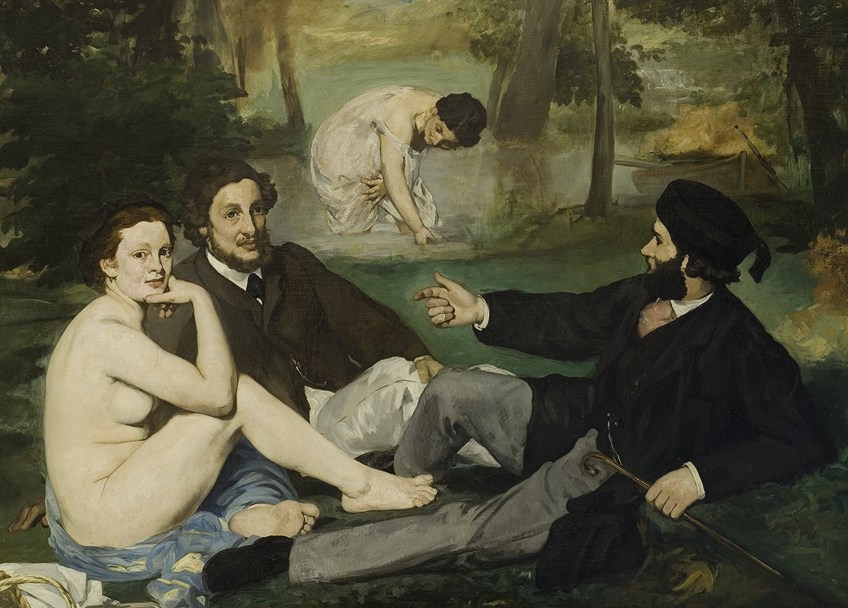
However, Manet borrowed characteristics from various History paintings and made it his own, or put a new twist on it as they say. Although Manet’s painting may have appeared a divergent delinquent of 19th-century French paintings, the artist most certainly had a raison d’être, so to say, and placed his subject matter with a purpose.
Some of the classical paintings he borrowed from included the engraving by Marcantonio Raimondi The Judgment of Paris (c. 1515), Giorgione’s – however, this has now been linked to Titian – The Pastoral Concert (c. 1510), The Tempest (c. 1508) by Giorgione, and Jean-Antoine Watteau’s La Partie Carrée (c. 1713).
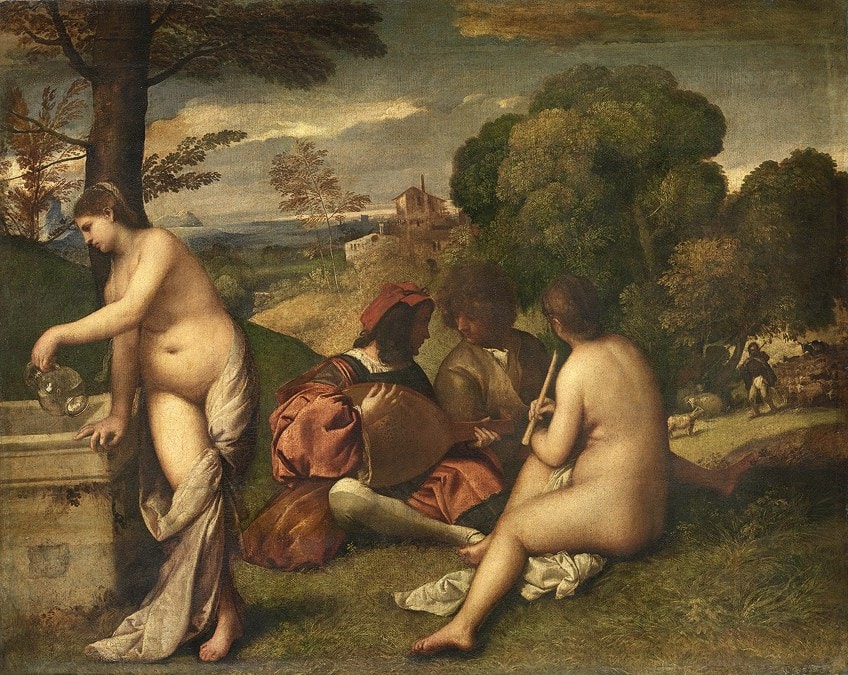
If we look at these paintings and engraving, the subject matter depicts several figures, of whom the women are nude with clad men, seen in The Pastoral Concert and The Tempest. However, there are also nude men in Judgment of Paris where the nude female sits just like the woman we see in Manet’s Luncheon on the Grass – we will discuss this further when we explore the subject matter in the formal analysis below.
Formal Analysis: A Brief Compositional Overview
Below we look at Le Déjeuner sur l’herbe in more detail, starting with a description of the subject matter and other artistic elements Manet utilized. We will also explore how this painting has often been questioned as depicting indoor motifs in an outdoor environment as well as who the woman was in the painting.
Subject Matter
Let us start in the foreground and move our way to the background, which in Luncheon on the Grass, Manet does not depict very far away, stylistically speaking, but we will get to that later. In the near foreground towards the left corner, there is a bundle of clothing appearing to have been discarded in a quick moment, including a basket lying on its side with various fruits and a loaf of bread lying outside the basket, as if it was knocked over.
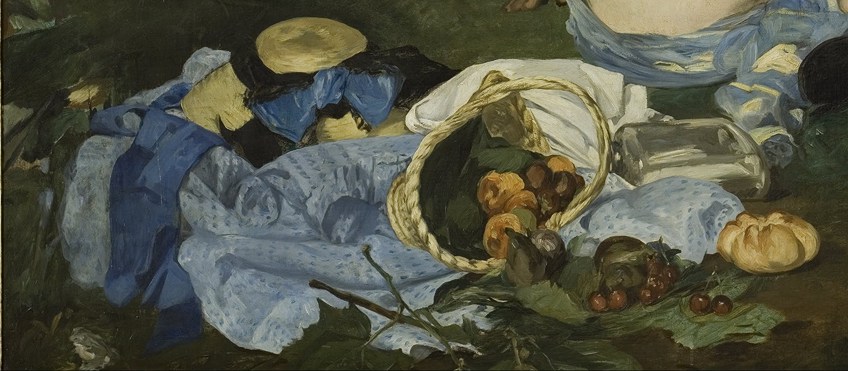
As we move towards the middle foreground, but almost in the center of the composition, there are three reclining figures on the grassy area, namely, a naked woman to the left, who appears to be sitting on a blue blanket, and two clothed men.
The woman sits with her right leg up, resting her right elbow on her knee and her thumb and forefinger cupping her chin. She looks in the direction of the onlooker. Furthermore, this is also a reminiscent pose of the woman we see from the Judgment of Paris by Raimondi, mentioned earlier.

An interesting fact about this woman is that we will see her appearance in Manet’s other painting Olympia (1863). Apparently, Manet painted from models who posed for him and there was one woman who posed in various of his paintings, her name was Victorine-Louise Meurent.
The men are clad in 19th-century attire attributed to dandies. One of the men is sitting to the woman’s left side and the other man appears to be sitting directly across the woman; however, both are close in proximity.
The man on the right is gesturing with his right hand and arm outstretched. He is leaning on his left elbow and his left hand holds on to a walking stick, typical of someone dressed for the outside. However, he wears a black hat with a flat top and a tassel, which was usually only worn inside.
The male figures who posed for Manet were his two brothers, Gustave and Eugène, who together reportedly made up the figure on the right-hand side. The male figure to the left was reportedly Ferdinand Leenhoff, whose sister, Suzanne Leenhoff, married Manet in 1863.
If we move towards the background, there is a woman bathing in a stream or river, wearing a diaphanous chemise gown. She is bending over with her right hand in the water and her head is slightly tilted to her right side. This is the side that is towards us, the viewers.
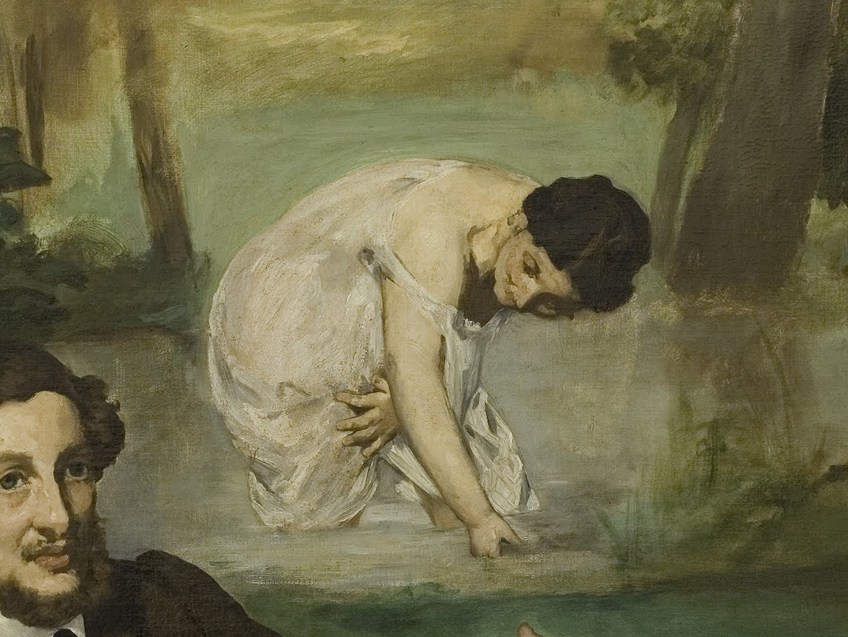
Let us further discuss the surrounding environment. The figures all appear to be in a forested grove. There are various trees surrounding them and the above-mentioned stream that seems to compose the rest of the background moving outwards to a far and distant landscape.
An important observation that has been widely debated in Luncheon on the Grass is that the two men are conversing with one another, apparently not engaging with the woman, who similarly, is not engaging with them.
If we look at all the figures, there is a general sense that no one is really engaging with the other.
Manet Bringing the Inside Out
It should also be noted that the setting of Manet’s Luncheon on the Grass has often been a topic of scholarly debate because there are elements that suggest it occurs outside, as is plainly visible, but some aspects denote that it may have been painted inside, in a studio.
This is a plausible point and important to remember that at the time Manet painted he was also exposed to photography, and this would have undoubtedly influenced his style.
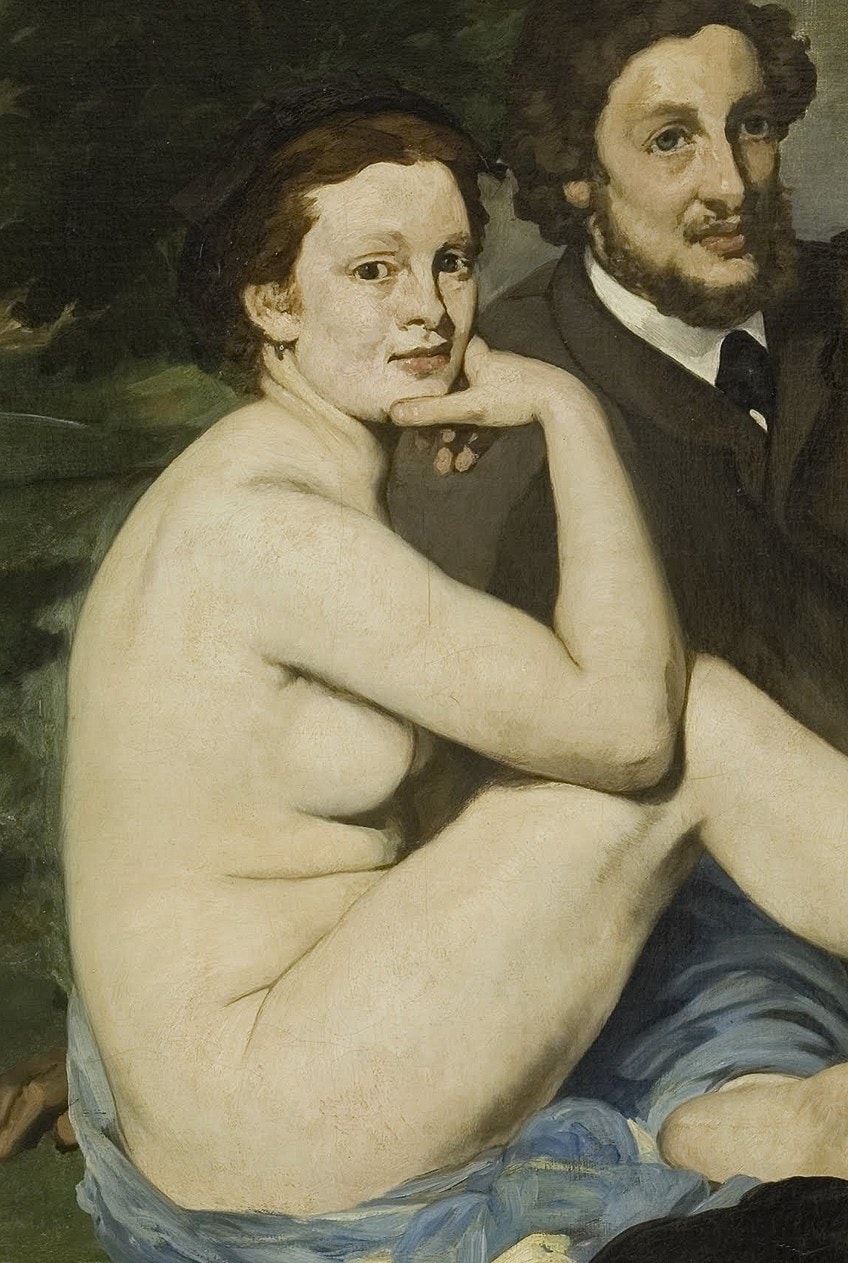
Examples that suggest how Manet could have brought the inside world out include the skin tone of the naked woman, suggesting a sort of harsh lighting on her as would be expected in a studio with lights shining on the model. Furthermore, the hat worn by the gentleman on the right indicates a hat that was usually worn indoors and not outdoors, and the said man’s walking stick is contrary to someone who would be inside because it is suggestive of the outside.
Color and Light
Discussing the way Manet utilized color and light in the Luncheon on the Grass painting almost goes together with the subject matter. What we mean here is that Manet painted his subject matter with loose brushstrokes that went against the Academic style of painting where clear lines and contours were acceptable. It is almost as if he painted in a haphazard manner.
Furthermore, the manner Manet utilized the idea of dark and light is evident in the figures, for example, the women are depicted in a lighter tone, while the men appear darker due to their clothing.
The woman staring at us is also stark in appearance; she lacks the tonal variations we would see from nude females in classical paintings. Most of her body is only one color, as if a harsh light shone on her, again suggesting this was in a studio.
We see dark areas of color that suggest tone on her, for example, under her right thigh, near her breasts, and by her elbow area. If we look at these closely, Manet seemed to have used stark grays and blacks to indicate these gradations of skin tone and where the shadows fell on it. Similarly, we see this “stark” tonality on Manet’s female figure in his painting Olympia (1863). Additionally, she also gazes at the viewers unflinchingly from her reclining position.
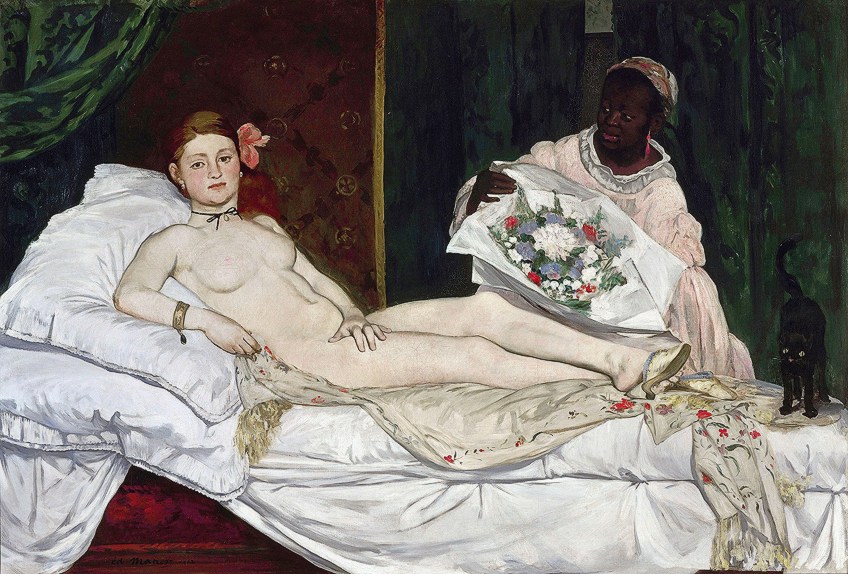
Perspective and Scale
An important aspect of Manet’s composition here, and one that has been widely spoken of, is the way he portrayed the perspective between the three figures in the center and the bathing woman in the background.
There appears to be no sense of depth or space between them and the woman in the background is depicted on almost a similar scale as the foreground figures.
If Manet followed the Academic painting rules the woman in the background would appear diminished in size to denote a sense of space and three-dimensionality, however, it is as if Manet imploded the illusion of depth in on itself.

Additionally, the actual size of the painting is large measuring approximately two by two meters, this would have added to the painting and its subject matter’s impact. When standing in front of the painting it would have undoubtedly caused quite a mix of emotions.
Le Déjeuner sur l’herbe Meaning
There has been extensive scholarly research over the meaning of Manet’s famous luncheon painting as well as a plethora of interpretations. However, what we do find from Manet’s painting are various polarities we find from life or “contrasting” elements.
For example, Manet pointed to the ideas of masculine and feminine by situating the females with their male counterparts. Similarly, he played on the ideas of light and dark, the females are depicted in light colors and the males in darker shades, and the ideas of nudity and wearing clothes.
Manet upended the ideas of how women were portrayed too, including his painting Olympia (1863), he depicted women with a sense of confidence and self-assurance. No longer a “coy” looking woman who stares bashfully at the onlooker, but a woman meeting the viewer directly with her gaze knowing she is naked.
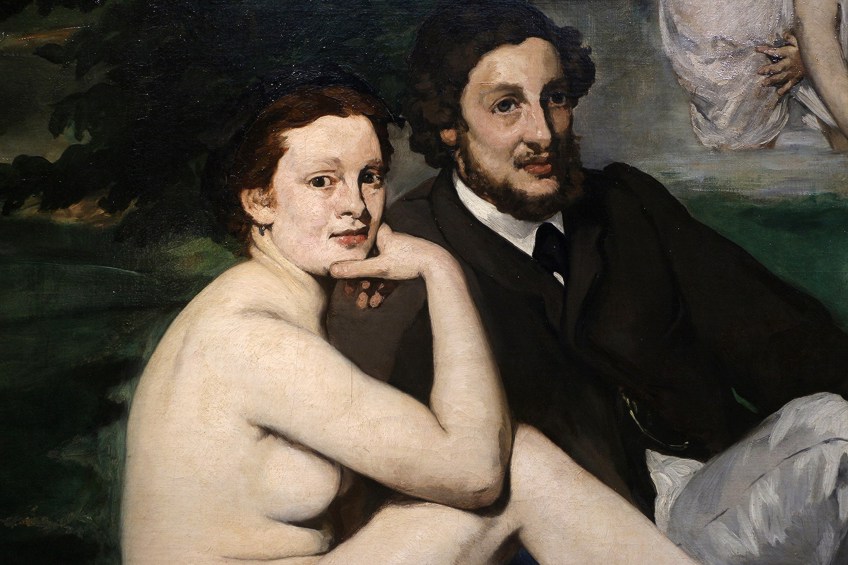
Other sources also say that Manet’s close friend Antonin Proust reportedly stated what Manet said to him one day when they were on the banks of the Seine and watching a woman bathing. Apparently, Manet said, “When we were in [Thomas Couture’s] studio, I copied Giorgione’s women, the women with musicians. It’s black that painting. The ground has come through. I want to redo it and to do it with a transparent atmosphere with people like those we see over there”.
What we can deduce from Manet’s “Luncheon on the Grass” painting is that he was interested in depicting scenes from ordinary life, and ordinary people.
He created a new subject matter that was his visual document of modern-day elements in Paris, a complete shift away from subjects that were mythological or religious, but ultimately not as real as a 19th-century woman having a picnic with a couple of gentlemen.
With this, some scholars have also looked to ideas of prostitution linked with Manet’s portrayal. Because the setting suggests a park-like environment where people can picnic, some believe Manet illustrated a famous park just outside Paris called Bois de Boulogne, where people also met for sexual liaisons, in other words, prostitution.
What People Said
When Le Déjeuner sur l’herbe was first exhibited in Paris it was viewed as scandalous and people were shocked and equally bewildered at the subject matter that was so different from what was expected. The French journalist and writer, Émile Zola is often quoted as giving a thorough description of Manet’s Luncheon on the Grass.
He exclaimed in his text: “what indecency!” when referring to the naked woman sitting right next to two clothed men and that it has “never been seen”.

Zola also described Manet as an “analytic painter” and that he does not have a “preoccupation with the subject which torments the crowd above all; the subject, for them, is merely a pretext to paint, while for the crowd, the subject alone exists”.
This is an important point to remember about Manet’s artistic style – he also painted to convey colors and light and the effects of these on his subject matter, additionally, his brushstrokes were looser than what was seen in traditional painting. In fact, this new style is what inspired many avant-garde artists who became known as the Impressionists.
Manet: Not Following the Rules
Manet’s famous paintings would continue to inspire many other artists after him, for example, the Impressionist Claude Monet painted a replica, also titled Le Déjeuner sur l’herbe (1865 to 1866), depicting several men and women all fully clothed having a picnic outdoors. The above-mentioned Zola also wrote a novel, L’Oeuvre (1886), which alludes to Manet’s Luncheon on the Grass as well as other artists from the 19th-century Paris art scene.
Other notable artists that were influenced by Manet included Paul Cézanne, Paul Gauguin, Pablo Picasso, the Dadaist Max Ernst, and many more who would utilize Manet’s famous theme of lunch on the grass, women, and nudity, and figuration and how it was portrayed in new formal techniques.
Manet certainly influenced the progression of a type of art where adherence to classical norms through the French Academy was lessened. Although he broke the rules of traditional painting, he simultaneously kept the tradition alive through his love of the “Old Masters” and continually pushed the boundaries of the evolution of painting, as would only be expected in a world developing at a fast pace moving into the 20th century and beyond. Manet was definitely an artistic marker that highlighted the beginning of something altogether new not only in art history but in art’s future.
Take a look at our Manet Luncheon on the Grass webstory here!
Frequently Asked Questions
Who Painted Luncheon on the Grass (1863)?
In French, it is titled Le Déjeuner sur l’herbe, meaning “The Luncheon on the Grass”, which was painted by the French artist Édouard Manet in 1863.
Where Is Manet’s Luncheon on the Grass (1863) Painting Now?
Édouard Manet’s Luncheon on the Grass (1863) painting is housed at the Musée d’Orsay in Paris.
Who Is the Woman In Manet’s Luncheon on the Grass (1863)?
Édouard Manet painted his figures with the help of models, notably Victorine-Louise Meurent, who was also a French artist. She reportedly posed as the woman in Luncheon on the Grass (1863), but also in Manet’s other painting titled Olympia (1863).
Alicia du Plessis is a multidisciplinary writer. She completed her Bachelor of Arts degree, majoring in Art History and Classical Civilization, as well as two Honors, namely, in Art History and Education and Development, at the University of KwaZulu-Natal, South Africa. For her main Honors project in Art History, she explored perceptions of the San Bushmen’s identity and the concept of the “Other”. She has also looked at the use of photography in art and how it has been used to portray people’s lives.
Alicia’s other areas of interest in Art History include the process of writing about Art History and how to analyze paintings. Some of her favorite art movements include Impressionism and German Expressionism. She is yet to complete her Masters in Art History (she would like to do this abroad in Europe) having given it some time to first develop more professional experience with the interest to one day lecture it too.
Alicia has been working for artincontext.com since 2021 as an author and art history expert. She has specialized in painting analysis and is covering most of our painting analysis.
Learn more about Alicia du Plessis and the Art in Context Team.
Cite this Article
Alicia, du Plessis, “Le Déjeuner sur l’herbe – Looking at Manet’s “Luncheon on the Grass”.” Art in Context. December 26, 2021. URL: https://artincontext.org/le-dejeuner-sur-lherbe/
du Plessis, A. (2021, 26 December). Le Déjeuner sur l’herbe – Looking at Manet’s “Luncheon on the Grass”. Art in Context. https://artincontext.org/le-dejeuner-sur-lherbe/
du Plessis, Alicia. “Le Déjeuner sur l’herbe – Looking at Manet’s “Luncheon on the Grass”.” Art in Context, December 26, 2021. https://artincontext.org/le-dejeuner-sur-lherbe/.








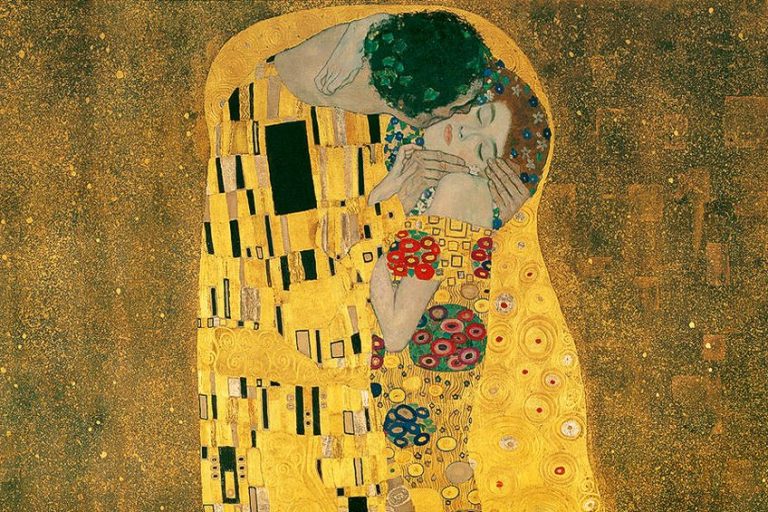



A fascinating analysis. I learned a lot about a number of different topics. This will influence how I look at other impressionistic paintings. Than you!
You’re welcome Martin, glad it helped you!
such a great and thorough analysis of Manet and the Luncheon on the grass. Thank you! This helped me understand some of Manet’s ideas much better.
Thank you so much, Maxima! I’m glad the analysis helped you gain a deeper understanding of Manet’s “Luncheon on the Grass.” It’s such a fascinating piece that challenges traditional norms of its time, and Manet’s use of composition and subject matter continues to inspire.